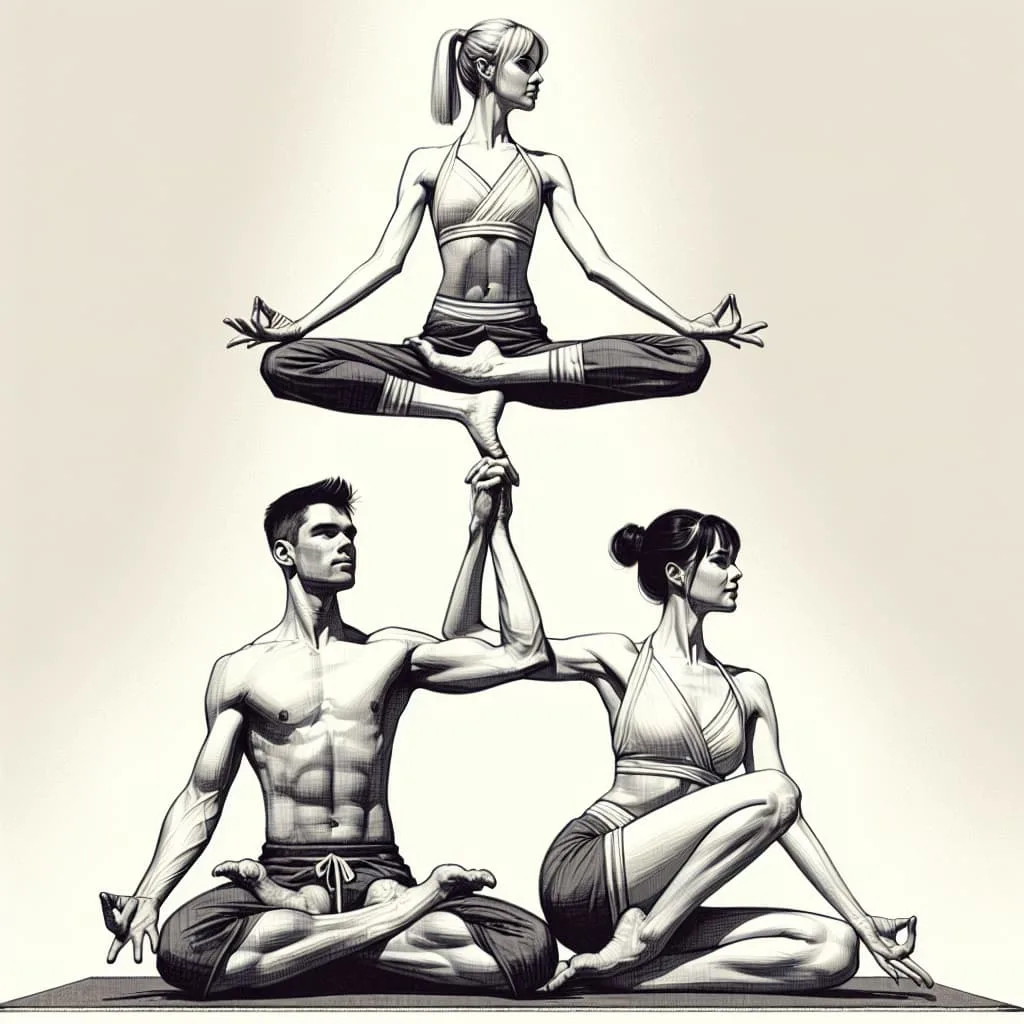Three-person yoga, also known as team yoga, is a dynamic practice. It involves three participants working together to perform poses that blend balance, strength, and flexibility. The practice eclipses the individual experience of yoga by building group dynamics and the flow between them.
This form of yoga is not only physically demanding but also mentally engaging. Each one must remain aware of his moves and those of his partners. The essence lies in harmony, coordination, and the shared energy that emerges through the unity of the group. This connection deepens the overall practice, creating a unique bond between partners.
This guide will introduce you to advanced three-person yoga poses. It will provide step-by-step instructions, safety tips, and modifications.
So, are you ready to take your practice to new heights?
Benefits of Practicing Three-Person Yoga
Three-person yoga offers many benefits beyond physical gains. This practice nurtures relationships, strengthens bonds, and enhances communication. It’s a holistic approach that enriches both body and mind, encouraging partners to grow as a team.
The mix of physical exertion and mental focus can lead to a great sense of perfection. Practicing yoga as a team gives a sense of triumph and shared success. In this setting, people experience yoga as a community, which can result in new friendships and connections.
Let me summarize the key benefits of engaging in three-person yoga:
- Improved physical strength and coordination
- Enhanced communication skills and trust
- Greater flexibility and balance
- Increased mental focus and awareness
- Strengthened relationships and connections
Mental and Emotional Advantages
Practicing yoga in a team setting can notably boost your mental health. The required focus aids in silencing the mind, giving a serene mental state. This sense of calm extends beyond the yoga session, influencing daily life positively.
Emotionally, three-person yoga creates an atmosphere that nurtures empathy and understanding. Sharing a difficult task with others deepens bonds and enhances emotional resilience. It provides a unique opportunity to gain insight into different perspectives, enriching personal growth.
Physical and Health Benefits
Three-person yoga is an excellent workout, offering key physical benefits. It enhances strength, flexibility, and balance through difficult poses that need coordination. This practice taps into muscles often neglected in traditional solo yoga, promoting a balanced body.
Regular practice can improve overall fitness and lower injury risk. It improves cardiovascular health by engaging different muscle groups and encouraging active participation. The collective energy harnessed during sessions adds motivation, enhancing the physical benefits for everyone involved.
Preparing for Advanced Three-Person Yoga Poses
Preparation is key when it comes to practicing advanced three-person yoga poses. This preparation involves more than just the physical aspect of yoga. Mental readiness and proper planning are equally important.
Before beginning, ensure that all participants are aware of the session’s goals. Discuss expectations and any concerns to provide an open, interactive environment. This groundwork aids in smoother transitions between poses and enhances the overall experience.
To prepare effectively, consider the following steps:
- Establish clear communication channels
- Familiarize everyone with the intended poses
- Organize necessary props and space
- Schedule regular practice sessions
Safety First: Tips to Avoid Injury
Safety is a top priority when aiming for difficult team yoga poses. Start by assessing each partner’s skill level. This ensures that everyone is comfortable and confident with the planned poses.
Always assign someone the role of a spotter. This person can assist with balance and provide support when needed. A vigilant spotter can prevent falls and ensure all poses are executed safely.
The Importance of Warm-Up and Cool-Down
A proper warm-up is key in preparing the body for demanding three-person yoga poses. It increases circulation and improves flexibility, reducing the risk of strains and injuries. Allocate time for joint rotations, gentle stretches, and breathing exercises.
Equally important is a cool-down period following the session. Cooling down helps in managing muscle soreness and brings a sense of closure to the practice. Incorporate gentle stretches and mindful breathing to conclude your yoga routine on a soothing note.
Advanced Three-Person Yoga Poses
Diving into advanced three-person yoga poses demands confidence and precision. These poses challenge strength, balance, and coordination like never before. Practicing them can elevate your skills and enhance group dynamics, offering a great sense of performance.
Each pose we will explore requires teamwork and a deep understanding among partners. Patience and practice are crucial as you move through these challenging formations. Let’s take a closer look at some of the most rewarding and intricate poses you can master.
Pose 1: The Triadic Lotus
The Triadic Lotus is a serene and balanced pose demanding grace and steadiness. Begin with one partner in a seated lotus position serving as the base. The second person balances on the base’s knees, forming a vertical line.
The top yogi stands atop the shoulders of the second person. This pose requires deep breath synchronization and alignment for stability. It’s a true test of harmony and trust among the partners.
Pose 2: The Pyramid of Strength

The Pyramid of Strength depicts power and structural stability. The base position consists of two partners, with knees and palms firmly planted on the ground. They serve as the foundation, locking their shoulders together for support.
The third partner climbs to balance atop the backs, forming a pyramid shape. This pose tests the core and teaches weight distribution. It’s a superb display of teamwork and synergy.
Pose 3: The Soaring Eagle Formation
The Soaring Eagle Formation is both majestic and demanding. It involves one partner acting as the stable base in a plank position. The second person positions perpendicular, lying along the planked base.
The third yogi climbs to balance on the outstretched arms of the second, mimicking the wings of an eagle. This pose requires immense core strength and trust among the team. Precision and calmness are key to executing it flawlessly.
Pose 4: The Triple Warrior Sequence
The Triple Warrior Sequence brings dynamic movement to the practice of team yoga poses. Begin with all partners standing in a line, each in a traditional Warrior II stance. With outstretched arms interlinked, it forms a continuous flow.
The pose transitions smoothly among the team, shifting weight between legs. It enhances coordination and highlights the collective grace of the group. The sequence is a powerful reminder of the unity and strength of synchronized movement.
The Role of Communication and Trust
Communication serves as the backbone of successful three-person yoga poses. Before beginning, establish clear signals and verbal cues to guide each move. This ensures everyone is on the same page, promoting a smooth transition into and out of poses.
Trust among partners is equally vital, as it nurtures confidence to attempt difficult formations. Knowing your partners will support and balance you is empowering. This trust translates into a seamless flow in practice and strengthens interpersonal connections. Over time, the group dynamic deepens, allowing for more complex and ambitious poses to be tackled together.
Incorporating Props and Modifications
Using props in three-person yoga can provide extra support and stability. Blocks, straps, and cushions help accommodate varying flexibility and strength levels. Props allow each partner to adjust poses to their needs, ensuring comfort and safety during practice.
Modifications are also crucial when dealing with differences in skill levels or physical limitations. Altering the pose’s depth or stance helps maintain proper alignment and balance. This personalized approach gives inclusivity, enabling everyone to participate and progress at their own pace within the group.
Building a Three-Person Yoga Routine
Creating a structured routine helps advance your practice in three-person yoga. Start with simpler poses and slowly introduce more complex sequences. This slow progression aids in building confidence and coordination amongst the group.
Incorporate a balanced mix of poses focusing on strength, balance, and flexibility. By varying the poses, you engage different muscle groups and keep the routine dynamic. Consistency and regular practice are key to mastering difficult poses and improving teamwork over time. Remember to include moments of reflection for personal growth and group feedback.
Conclusion: The Journey of Team Yoga
The journey of team yoga is a path rich with growth and bonding. Practicing three-person yoga poses offers a unique experience beyond the physical aspect. It strengthens ties between partners, giving a spirit of teamwork and shared success.
By embracing the challenge of three-person yoga, partners enhance their understanding of teamwork, communication, and trust. The skills and connections developed here can extend into everyday life. Cherish each moment of progress and celebrate the unity your team yoga practice brings.
FAQs About Three-Person Yoga
Curious about how to safely start three-person yoga? Begin with simpler poses and slowly advance. Practice with partners you trust to ensure safety and enjoyment.
Wondering about the physical benefits? Regular practice builds strength, balance, and flexibility, giving benefits to all partners. It combines challenges with the joy of shared success.
Are adjustments possible for different skill levels? Yes, adapt poses as needed to shelter various abilities. Use props for added support during challenging positions.
What role does communication play? It’s vital for successful execution and avoiding injury in three-person yoga. Clear communication enhances coordination and understanding among partners.
Looking to improve your practice? Incorporate a mix of solo, duo, and three-person poses into your routine. This variety will refine your skills and boost your confidence, enriching your yoga journey.
